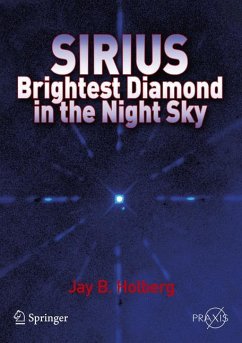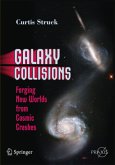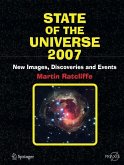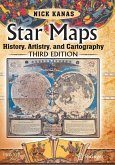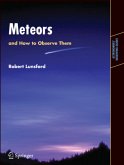Sirius - A Diamond in the Night will tell two stories. The first and most obvious is why the star known as Sirius has been regarded as an important fixture of the night sky by many civilizations and cultures since the beginnings of history. A second, but related, narrative is the prominent part that Sirius has played in how we came to achieve our current scientific understanding of the nature and fate of the stars. These two topics have a long intertwined history, and the telling of one story eventually leads back to the other. Presently, new observations from space are revealing, in precise terms, how stars like Sirius and the Sun have evolved and what they will ultimately become, while at the same time answering some of the age-old questions about Sirius.
The book is divided into five parts. The first (Chapters 1 and 2) describes how Sirius was viewed by the ancient civilizations of Egypt, Greece and Rome. The second part (Chapters 3-5) describes how early astronomers sought to determine the nature of the stars, including the prediction that Sirius possessed an unseen companion and the eventual discovery of this white dwarf companion 18 years later. The third part (chapters 6-9) describes the major discoveries in stellar astrophysics revealed by observations of Sirius. The fourth part (chapters 10 and 11) probes the modern scientific and pseudo scientific controversies involving Sirius, including the 'Red Sirius' and Dogon tribe stories. The final part (Chapters 12 and 13) highlights modern observations made with the Hubble Space Telescope and other spacecraft of the white dwarf companion.
Hinweis: Dieser Artikel kann nur an eine deutsche Lieferadresse ausgeliefert werden.
The book is divided into five parts. The first (Chapters 1 and 2) describes how Sirius was viewed by the ancient civilizations of Egypt, Greece and Rome. The second part (Chapters 3-5) describes how early astronomers sought to determine the nature of the stars, including the prediction that Sirius possessed an unseen companion and the eventual discovery of this white dwarf companion 18 years later. The third part (chapters 6-9) describes the major discoveries in stellar astrophysics revealed by observations of Sirius. The fourth part (chapters 10 and 11) probes the modern scientific and pseudo scientific controversies involving Sirius, including the 'Red Sirius' and Dogon tribe stories. The final part (Chapters 12 and 13) highlights modern observations made with the Hubble Space Telescope and other spacecraft of the white dwarf companion.
Hinweis: Dieser Artikel kann nur an eine deutsche Lieferadresse ausgeliefert werden.
From the reviews:
"This book is wonderful, being an authoritative and connected history of Sirius as seen throughout the ages. ... I am highly impressed by the original new research reported in this book. ... I could imagine that this book would be good for constructing an astro-history course around. ... But mainly, for people like us, it is a great story with a lot of new information." (HAD News, Vol. 70, May, 2007)
"To write a complete book about a single star may sound like a daunting task, but Jay Holberg, a senior research scientist at the lunar and planetary laboratory in Arizona, has done so with success. ... The book is meticulously researched ... . It's a fascinating read and will appeal equally to the newcomer to astronomy and to the serious student. This is recommended without the slightest hesitation." (Patrick Moore, BBC Sky at Night, July, 2007)
"Sirius, the brightest star in the night sky, has been of human interest at least since early Egyptian priests watched for its heliacal rising as a sign that the Nile would soon flood and fertilize the fields. ... Ample bibliography for further investigation. Summing Up: Recommended. General readers; lower-division undergraduates through faculty." (M. Dickinson, Choice, Vol. 45 (1), 2007)
"Jay Holberg has chosen Sirius as the subject of this charming and well-written book which covers both the lore and the physics of the brighter star in the sky. ... I thoroughly recommend this book as an instructive and entertaining read (Holberg is good at the apposite analogy), and as one that discusses the early 20th-century advances in astrophysics, which are often ignored in popular books, but underlie our modern understanding of stars." (William Tobin, Southern Stars, Vol. 46 (2), June, 2007)
"This book is wonderful, being an authoritative and connected history of Sirius as seen throughout the ages. ... I am highly impressed by the original new research reported in this book. ... I could imagine that this book would be good for constructing an astro-history course around. ... But mainly, for people like us, it is a great story with a lot of new information." (HAD News, Vol. 70, May, 2007)
"To write a complete book about a single star may sound like a daunting task, but Jay Holberg, a senior research scientist at the lunar and planetary laboratory in Arizona, has done so with success. ... The book is meticulously researched ... . It's a fascinating read and will appeal equally to the newcomer to astronomy and to the serious student. This is recommended without the slightest hesitation." (Patrick Moore, BBC Sky at Night, July, 2007)
"Sirius, the brightest star in the night sky, has been of human interest at least since early Egyptian priests watched for its heliacal rising as a sign that the Nile would soon flood and fertilize the fields. ... Ample bibliography for further investigation. Summing Up: Recommended. General readers; lower-division undergraduates through faculty." (M. Dickinson, Choice, Vol. 45 (1), 2007)
"Jay Holberg has chosen Sirius as the subject of this charming and well-written book which covers both the lore and the physics of the brighter star in the sky. ... I thoroughly recommend this book as an instructive and entertaining read (Holberg is good at the apposite analogy), and as one that discusses the early 20th-century advances in astrophysics, which are often ignored in popular books, but underlie our modern understanding of stars." (William Tobin, Southern Stars, Vol. 46 (2), June, 2007)
